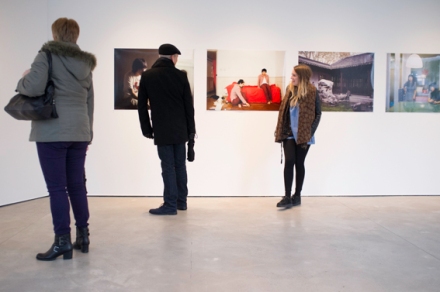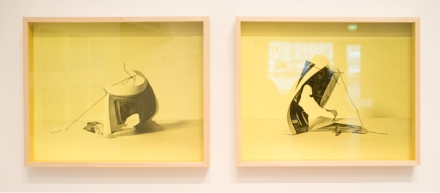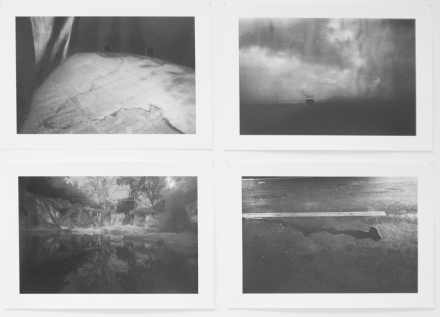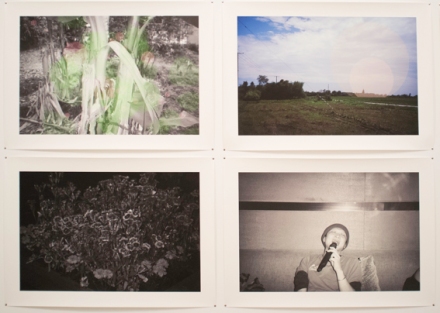The study visit to the Open Eye Gallery in Liverpool last week to see the exhibition “A Lecture Upon The Shadow” was a suggestion I made after reading Dewald’s ‘We Are Oca’ report – here – from a similar show in Shanghai last year. I thought it might be interesting to contrast and compare, I didn’t expect to be as challenged as I was. For various reasons I have been too busy to write my feelings for the exhibition and the intervening time has had me periodically thinking about the work and in particular the notion of shadow and the work of Liang Yue, that I found stuck in my mind. The notion of the shadow has crept into my understanding, my reading of the works.
I can’t say I liked Yue’s work, I had a great deal of difficulty trying to describe what I felt about the wall of work, a kaleidoscope as one student put it, of fifteen large prints pinned in regular formation on one white wall of the gallery.
Man Yi’s work of monochrome images on the other hand were ‘easier’ to view. “Memories of Water” displayed ten images, again pinned (or part pinned) onto their own white wall. The references to water were in the most part explicit, but their inconsistency was their only consistency. These few images had abstract images and figurative images; images depicting details contrasting with large vistas, of seemingly new image technology and old. That Shanghai hosts China’s greatest river as it enters the East China Sea, the Yangtze, might, to this westerner impel a connection to water, but it maybe to do with the transitory nature of this vast city, of some twenty three million souls and counting, that I kept being pulled back to when looking at the work of Man Yi and Liang Yue.
Yue’s images were taken during twilight, the neither day nor night time, a period, a time, of transition. A time that is not what it was, nor is yet to be. The artist assisted occasionally with a torch… “The images are shot in twilight, just before nightfall, and are linked to an elusive time and the question of presence” – from the catalogue and exhibition notes at the gallery. The ambiguity that the images provides as regards ‘a place’ or ‘a time’, seem again, to this western viewer about the ambiguity of the place that they were taken in – Shanghai. That this city, that has more than once defied logic to grow in size when the prospects of growth appeared limited, seem to harken to the notion that this place is no longer what it was and isn’t yet what it will be. The influence of the West, for two generations under communist rule the ‘other’ in Chinese society is now becoming all-pervasive and I feel now, on reflection that the work of these two Shanghai artists were a reaction to that/this continued process of change. In many ways the work seemed ambivalent to both the encroaching ‘creep’ of consumerism as well as to it’s past, with it’s inherent darkness. Shanghai has had a cosmopolitan population for hundred’s of years and the Yangtze connects this outward looking sea port with the old capital Nanjing with its inherent historical links. The Japanese came through Shanghai less than a century ago, and about a century before that the Chinese failed to repel the British during the Opium wars. That I ‘see’ an ambiguity in these images is almost certainly part of how I see China. Again from the accompanying exhibition notes regarding Yue… “The recurring images are a partial and instant view of the city. Her scenes of distant frenzy co-mingle possibility and problem, and leave the viewer uncertain about their specific mood and theme. The contrast between familiarity and strangeness is greatly pronounced, and it is precisely this feeling of contradiction that makes her photos so fascinating and attractive.”

Parents and child in front of Fan Shi San’s ‘Two of Us’ at the Open Eye Gallery Feb 9th 2013. Image courtesy of the Open Eye Gallery
Also on view was Fan Shi San’s project ‘Two of Us’. San explore’s Chinese experiment with population control. The use of double exposure photography brings twin instances of the same person to the frame and leaving the viewer to connate the emotional stress between them. Wondering which is which, who is who? These expressionless subjects exhibit a loneliness that immediately draws the viewer in which works very successfully, but I wonder about the ‘Chineseness’ of it all. India has a covert population control system, whereby parents are questioning the on-going pregnancy if they find they are carrying a female child. That the artist is allowed to ask questions on the policy is, in western eyes, progress, though general discussion on this one child policy is now becoming a more overt common topic for the Chinese population, questioning the legislation of the ruling body isn’t one that is done habitually even in the relatively “relaxed” climate of today’s China.
As I remarked in Dewald’s original review I was drawn to Ishiguro’s ‘Never Let Me Go’ about the use of clone’s to provide organs for transplant. In the book the clone’s are kept separate and are never allowed to meet their donor clone, however their sense of humanity drives some to strive to discover their ‘other half’ and it is this that I saw in this work. What though if they did meet; the one knowing they were a clone of the other and doomed to die in order that others might live, the other knowing that their clone, literally another of them in their own likeness and a part of them, would die a parentless, childless, lonely death? I saw that in these images. Ishiguro also wrote about Shanghai, curiously called “When We Were Orphans” – but that is, as they say, another story. And back to Donne, weren’t these ‘others’ in these photographs shadows of themselves or perhaps themselves as shadows?
Tabitha Jussa’s “Eldon Grove”, a shadow of it’s former self composing “fifty individual negative images composited together digitally to create an impossible view of the buildings, a ‘heightened realism’.” Exhibition Guide. This very large single image, could have provided more impact with more context I felt. The exhibition notes denoted all we needed to know, and provided no more. The image of urban decay is a trope well rehearsed in today’s culture and I’m not sure how much this individual image, set in amongst others with subtler narratives, brought to the conversation. Another of Jussa’s work “Match Day” to my mind works much better, habituating the people within ‘their place’ in pieces such as “Walton Beck Road, No 4, 2011”. To my mind the absence of people in”Eldon Grove”, absented the ‘person’ from the place, traces of ‘them’ weren’t there, whereas the sea of Red supporters on match day foregrounds the people, the older city dwellings and the Anfield stadium which is at the heart of a lot the planning blight in this part of Liverpool and at the core of the notion of change in this part of the city.

Detail, David Penny’s Dutch Painting at the Open Eye Gallery Feb 9th 2013. Image courtesy of the Open Eye Gallery
David Penny’s work had the look of Sailing Ships to me, sails in full wind, rigging and photographed as three dimensional structures. mounted under either yellow or blue perspex. Using photographs of sculptures, these become objects in themselves, though I am struggling with how these are connected to the theme of shadow, perhaps they only do so because they are in the exhibition, or perhaps the very visual shadow in the image is it. I’m not sure. They were the only ‘objectified images’ in the exhibition, framed with the use of coloured interjections between eye and object, they were like David Jaques “Corpus Mercatorium” seemingly at odds with some of the other work. Jacques work may have worked better for me with a lot more research into the characters he portrayed in the images, maybe not. I kept being drawn back to it on the day, recognising one or two of the faces; but overall that particular enigma eluded me.
A very well worthwhile visit with a lot of discussion. I travelled a good part of the way there and back with AnneD and curiously we were joined for part of the journey home by a photography graduate who tuned into our conversation and added some comments of his own – he works for his father in civil engineering, such has been his success in finding a job as a photographer.


I’ve been wondering if you think that Donne’s poem is a fitting capsule for the Exhibition.
In a metaphysical sense yes, but perhaps no. Good study visit though
No I haven’t worked out how David Penny’s is to do with shadow, unless the whole exhibition wasn’t so much about shadow as light – since you don’t get one without the other, and photography is all about light…
Then again maybe its about the long dark shadow of traditional painting (as symbolised by the Dutch paintings) looming over us contemporary artists:-)
And the long Spanish shadow over the Dutch? Oh, the road goes ever on….